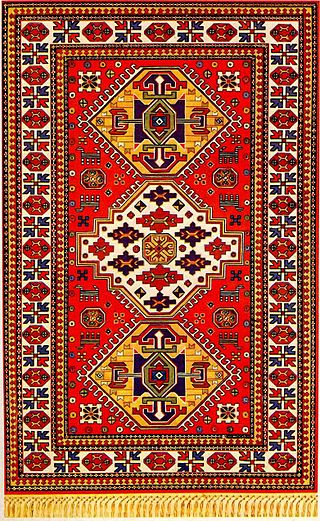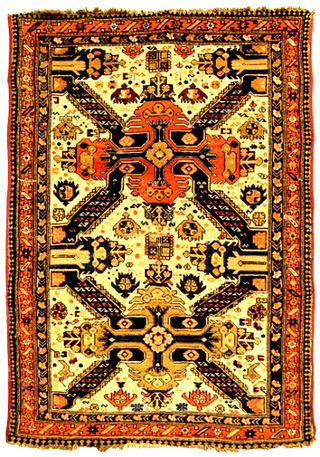
Tabriz is a city in northwestern Iran, serving as the capital of East Azerbaijan Province. It is the sixth-most-populous city in Iran. In the Quru River valley in Iran's historic Azerbaijan region between long ridges of volcanic cones in the Sahand and Eynali mountains, Tabriz's elevation ranges between 1,350 and 1,600 m above sea level. The valley opens up into a plain that gently slopes down to the eastern shores of Lake Urmia, 60 km (37 mi) to the west. With cold winters and temperate summers, Tabriz is considered a summer resort. It was named World Carpet Weaving City by the World Crafts Council in October 2015 and Exemplary Tourist City of 2018 by the Organisation of Islamic Cooperation.

East Azerbaijan Province is one of the 31 provinces of Iran. It is located in Iranian Azerbaijan, bordering Armenia, Republic of Azerbaijan, Ardabil province, West Azerbaijan province, and Zanjan province. The capital of the province is Tabriz. East Azerbaijan province is in Region 3 of Iran, with its secretariat located in its capital city, Tabriz.

A Persian carpet or Persian rug, also known as Iranian carpet, is a heavy textile made for a wide variety of utilitarian and symbolic purposes and produced in Iran, for home use, local sale, and export. Carpet weaving is an essential part of Persian culture and Iranian art. Within the group of Oriental rugs produced by the countries of the "rug belt", the Persian carpet stands out by the variety and elaborateness of its manifold designs.

Azerbaijan or Azarbaijan, also known as Iranian Azerbaijan, is a historical region in northwestern Iran that borders Iraq, Turkey, the Nakhchivan Autonomous Republic, Armenia, and the Republic of Azerbaijan.

A Tabriz rug/carpet is a type in the general category of Persian carpets from the city of Tabriz, the capital city of East Azarbaijan Province in north west of Iran. It is one of the oldest rug weaving centers and makes a huge diversity of types of carpets. The range starts at Bazaar quality of 24 raj and on up to the incredibly fine 110 raj. Raj is the unit of knot density. It shows the rigidity of the rug which based on the number of strings used for the foundation of the rug. Strings materials are usually made of cotton or silk which is used for very fine rugs.
An oriental rug is a heavy textile made for a wide variety of utilitarian and symbolic purposes and produced in "Oriental countries" for home use, local sale, and export.

Anatolian rug is a term of convenience, commonly used today to denote rugs and carpets woven in Anatolia and its adjacent regions. Geographically, its area of production can be compared to the territories which were historically dominated by the Ottoman Empire. It denotes a knotted, pile-woven floor or wall covering which is produced for home use, local sale, and export. Together with the flat-woven kilim, Anatolian rugs represent an essential part of the regional culture, which is officially understood as the Culture of Turkey today, and derives from the ethnic, religious and cultural pluralism of one of the most ancient centres of human civilisation.
Iranian handicrafts are handicraft or handmade crafted works originating from Iran.

Ardabil rugs originate from Ardabil located in the province of Ardabil Province in northwestern Iran, 639 kilometers from Tehran. Ardabil has a long and illustrious history of Persian carpet weaving.
Quba rugs and carpets are named for a town that is located in Azerbaijan Republic not far from the Caspian Sea; therefore, making Kubas a sub-division of Caucasian carpets. 1 Kuba is at once a city and an area that was formerly a Khanate of Azerbaijan.2 Within the Kuba genre itself, there exist many subdivisions including: Alpan-Kuba, Karagashli, Konaghend, Chi Chi, Perepedil, Seychour and Zejwa.3
Azerbaijani art is the art created by Azerbaijanis. They have created rich and distinctive art, a major part of which is applied art items. This form of art rooted in antiquity, is represented by a wide range of handicrafts, such as chasing (metalworking), jewellery-making, engraving, carving wood, stone and bone, carpet-making, lacing, pattern weaving and printing, and knitting and embroidery. Each of these decorative arts is evidence of the culture and the abilities of the Azerbaijan nation, and are very popular there. Many interesting facts pertaining to the development of arts and crafts in Azerbaijan were reported by merchants, travellers and diplomats who visited these places at different times.

Ganja rugs or Geunge rugs are a category of Caucasian rug from the town of Gəncə, Azerbaijan, also written Geunge, Gendje or Ganja. Gəncə is located between the weavings areas of Karabagh, Kazakh and Shirvan and it also acted as a marketing centre for weaving from those surrounding areas.

Gasimushaghi carpets are Azerbaijani pile carpets of the Karabakh school of the Jabrayil group.

"Aghajly" - Azerbaijani carpets belonging to the Tabriz type. These carpets got their name not from the place of their production, but in accordance with their composition. Thus, the composition of the middle field of these carpets mainly consists of one or more trees and bushes and, in rare cases, of a group of trees intended to represent a garden or forest. The trees are represented differently. The spring or autumn trees are usually in bloom or with fruits, and sometimes these are cypress, willow, weeping willow and other ornamental trees.

"Shabalyt buta" - Azerbaijani pile carpets part of the Karabakh group of the Karabakh type. The "Shabalyt buta" carpets belong to the complex composition of the Karabakh carpets. The main centres of production of the "Shabalyt buta" carpets were Jabrayil, Aghdam and Mugan. In an earlier period, carpets of the same pattern were woven at carpet weaving points located in the Iranian Azerbaijan, but they were rougher than the Karabakh ones. The silk carpets “Shabalyt buta” woven in Jabrayil were very popular.

“Shedde”, ) are Azerbaijani lint-free carpets part of the Karabakh group of the Karabakh type. These carpets were produced mainly in Nakhchivan, in Aghjabedi, Aghdam, Gubadly and Jabrayil districts of Azerbaijan.

"Borchaly" describes a sub-category within the Gazakh group of Azerbaijani carpets, even though the region from which they originate is now within Georgia. The name of this carpet is associated with the name of the Borchaly region, located to in southeastern Georgia close to the border of Gazakh district, Azerbaijan. Large villages of this region including Gurdlar, Akhurly, Kachagan, Sadakhly (Sashikhly), Dashtepe and Lembeli were once famous for carpet weaving, though in recent decades the art of carpet weaving has almost entirely died out, leaving only two known villages where Borchaly style carpets are still woven: Kosalar and Mughanlo. The population of Borchaly including the above-mentioned villages consists mainly of ethnic Azerbaijanis.

"Demirchilar" - Azerbaijani carpets belonging to the Gazakh group of the Ganja-Gazakh type. The name of this carpet is associated with the name of the village of Demirchilar located 9 kilometres west of the city of Gazakh in Azerbaijan. Some carpet experts call this carpet "Demirchi Hasan". This carpet is also produced in the villages of Dash Salakhli, Kosalar, and Urkmazli from the Gazakh district. Demirchilar carpets are considered to be of the highest category carpets in the Gazakh group.

"Khila-Afshan" - pile carpets belonging to the Baku group of Absheron carpet weaving school.

Gollu-chichi or Gollu carpets — Azerbaijani carpets belonging to the Guba school of carpet weaving.
















